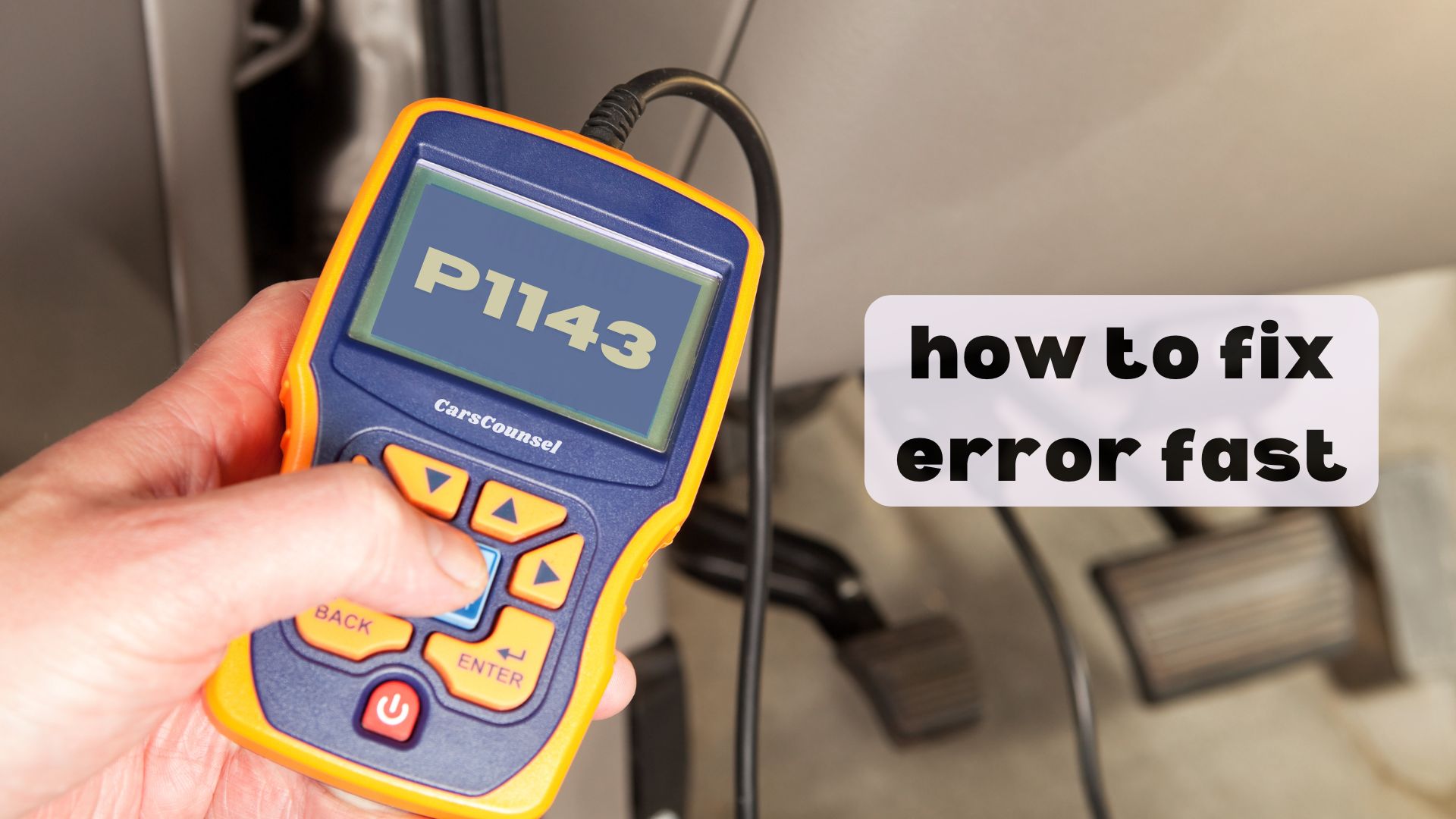While a well-functioning engine purrs smoothly, a malfunctioning one can lead to frustrating issues like the P1143 code. This code indicates a problem with the Heated Oxygen Sensor 1 Lean Shift Monitoring for Bank 1, essential for maintaining the ideal air-fuel ratio. You’ll notice symptoms like decreased fuel efficiency and rough idling. To address this, you’ll need to inspect the sensor and check for vacuum leaks, but that’s just the beginning of diagnosing the root cause.

Quick Navigation
Key Takeaways
- P1143 code indicates a problem with Heated Oxygen Sensor 1 in Bank 1.
- It affects air-fuel ratio monitoring, leading to potential combustion issues.
- Causes include faulty sensors, fuel system problems, and vacuum leaks.
- Symptoms include decreased fuel efficiency and rough idling.
- Repair involves inspecting and possibly replacing the oxygen sensor.
Understanding the P1143 Code
Understanding the P1143 Code involves recognizing it as a diagnostic trouble code (DTC) that indicates an issue with the Heated Oxygen Sensor 1 Lean Shift Monitoring in Bank 1.
This sensor uses oxygen sensor technology to monitor oxygen levels in exhaust gases, helping maintain the ideal air-fuel ratio for efficient combustion. A malfunction can lead to a lean air-fuel mixture, affecting engine performance.
The code suggests potential issues with combustion efficiency, often requiring inspection of the oxygen sensor and related systems to guarantee accurate air-fuel ratio adjustments.
Causes of the P1143 Error
When diagnosing the P1143 code, you’ll likely encounter several potential causes that affect the Heated Oxygen Sensor 1 Lean Shift Monitoring in Bank 1. Common issues include oxygen sensor failure and fuel system issues.
| Cause | Description |
|---|---|
| Oxygen Sensor Failure | Faulty sensor disrupts air-fuel mixture monitoring. |
| Fuel System Issues | Problems with injectors or pressure regulators affect fuel delivery. |
| Vacuum Leaks | Intake system leaks introduce excess air, causing lean mixtures. |
Symptoms of P1143
If you encounter the P1143 code, you’re likely to experience several noticeable symptoms that affect your vehicle’s performance.
A lean mixture caused by a sensor malfunction can lead to decreased fuel efficiency and rough idling with vibration.
Engine misfires may occur, resulting in power loss and erratic performance during acceleration.
The Check Engine Light will illuminate, signaling a problem.
These symptoms indicate potential combustion efficiency issues that need prompt attention to prevent further damage.
Diagnosing the P1143 Issue
Diagnosing the P1143 issue involves a systematic approach to identify the root cause of the problem.
You’ll use diagnostic tools to inspect the oxygen sensor and related systems.
Key steps include:
- Sensor Inspection: Check the heated oxygen sensor for faults.
- System Checks: Look for vacuum leaks and fuel system issues.
- Sensor Calibration: Confirm proper sensor calibration to maintain accurate readings.
This process helps you pinpoint the exact cause and apply the correct fix.
Repairing the P1143 Code
Repairing the P1143 code involves a methodical approach to address the underlying issues.
You’ll need to use a scan tool to identify the problem and inspect relevant systems. If the issue is with the oxygen sensor, you’ll perform a sensor replacement.
Additionally, check the fuel system for any malfunctions, such as faulty injectors or a pressure regulator. Confirm there are no vacuum leaks in the intake system.
After repairs, clear the DTC and reset the ECM to verify that the fixes are effective.
Cost Considerations for P1143 Repairs
When addressing the P1143 code, you’ll need to evaluate the costs associated with fixing the underlying issues. This involves setting a repair budget that considers potential expenses for parts and labor.
Here are key cost considerations:
- Oxygen Sensor Replacement: Typically costs between $150 to $300.
- Additional Repairs: Vacuum leaks or fuel system issues may incur extra costs.
- Service Warranty: Check if your vehicle’s service warranty covers any of these repairs to help offset expenses.
Preventing Future P1143 Issues
To prevent future occurrences of the P1143 code, it’s vital to maintain your vehicle’s engine and related systems regularly.
Regular sensor maintenance is important, as faulty oxygen sensors can disrupt the air-fuel mixture, leading to performance issues. Verify that your vehicle’s oxygen sensors are inspected and replaced as needed.
Additionally, check for vacuum leaks and verify proper fuel system operation to maintain an ideal air-fuel mixture.
Regular checks can help prevent the P1143 code from reappearing, verifying better engine performance and efficiency.
Troubleshooting Additional Related Problems**
Troubleshooting additional problems related to the P1143 code involves a systematic approach to identify and address potential issues that might be contributing to the error.
You should conduct sensor testing to verify the oxygen sensor’s functionality and perform fuel analysis to check for any imbalances in the air-fuel mixture.
Consider these steps:
- Inspect the intake system for vacuum leaks.
- Check the fuel system for proper pressure and flow.
- Test the exhaust system for leaks before the oxygen sensor.
More OBD-II Codes
| P1142 | P1140 | P1139 | P1141 |
| P1138 | P1137 | P1222 | P1221 |
| P1214 | P1213 | P1212 | P1173 |
| P1325 | P1245 | P1244 | P1243 |
| P1225 | P1224 | P1223 | P2BA8 |
| P2A04 | P1859 | P1513 | P1512 |
Frequently Asked Questions
Can P1143 Affect Vehicle Emissions Tests?
You’ll likely fail emissions testing if your vehicle has issues affecting air-fuel mixtures, as they impact emissions. Diagnostic tools can help identify problems like faulty sensors, which must be fixed to pass emissions testing.
Does P1143 Impact Engine Longevity?
You’ll face a million problems if your engine performance suffers due to poor sensor calibration. P1143 can impact engine longevity by causing inefficient combustion, potentially leading to premature wear on critical components.
Can P1143 Be Caused by Faulty Spark Plugs?
Faulty spark plugs typically don’t cause P1143 directly. However, you should check sensor diagnostics to verify no indirect effects from misfires. Spark plug types can influence engine performance, but they’re not a primary cause of this code.
Is P1143 Specific to Certain Vehicle Models?
Precise problem-solving prompts you to check if P1143 is specific to certain vehicle models. While P1143 symptoms and repair processes are generally applicable, definitions can vary by manufacturer, affecting P1143 symptoms and repair approaches.
Can P1143 Be Temporarily Fixed Without Replacement?
You can’t temporarily fix P1143 without replacement. However, using diagnostic tools can help identify underlying issues. Temporary solutions might involve clearing codes or adjusting fuel trim, but these are not lasting fixes.
Conclusion
As you navigate the P1143 code, bear in mind that a faulty oxygen sensor can be the Achilles’ heel of your engine, leading to a lean air-fuel mixture and decreased performance. Like a ship without a rudder, your vehicle may struggle to stay on course. By replacing the sensor and addressing related issues, you can steer your engine back to peak performance, avoiding costly repairs down the road.

